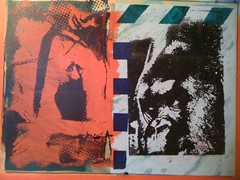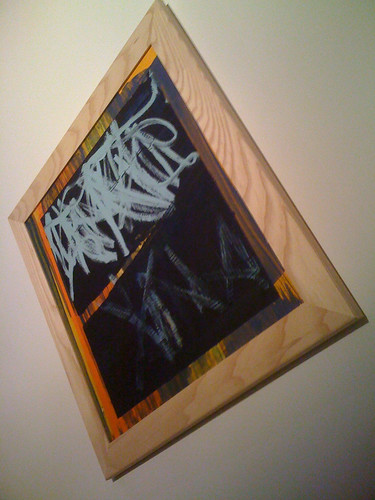Screenprint on canvas.
Printmaking Workshop
Saturday 11th June 2011 - 10-1.30pm
West Buckland School, Barnstaple, Devon
EX32 0SX
Room: Print Room in the 150 Building
Teacher: Peter Bright
Course Aims: A hands on introduction to woodcuts and how to create a series of prints. Within the time frame it is hoped that each participating member will be able to create a finished image. The techniques shown will be simple 'kitchen table' processes that will be easy to replicate at home. Read more about my work .. .
Equipment needed: All materials are provided.
Additional costs: No additional costs.
Refreshments: Tea, coffee and biscuits will be provided.
Location:West Buckland School, Barnstaple. As you turn onto the school site, take the left turning to the car park. The 150 building is located adjacent to the main car park, and the front door is at the far end of the building as you walk towards it.
Cost: £28.75. There is a 15% discount to current WBS parents and staff, and would ask that all course places are pre-booked.
For further details of the above courses, or to request a booking form please contact Karen Wicks:
kaw@westbuckland.devon.sch.uk ...or go to Evolve 150 for details of other courses or download a booking form.
Welcome Below are entries from the Blog
Painting for Broomhill exhibition, 55" x 55" oil on canvas
'Walk Away or Jump'
Inspired by a cliff walk with one of Robert Rauschenberg's assistants in 1979. During 1979 I was in a band called 'The Urge', who were discovered by an A&R man from Beggars Banquet Records, who saw us play at my degree show at Exeter College of Art. We ended up supporting 'Bauhaus', 'Adam and the Ants', 'The Pack' and many other Post Punk heroes. We were offered a record contract and the A&R man became our manager and Rauschenberg's former assistant also became an important member of our team.
I lived near Exmouth and often walked across the beach and along the cliffs - this time I was accompanied by Rauschenberg's assistant who had been staying with me. At the highest point he confessed his love for me, which was a bit of a shock and I replied 'I'm sorry but I prefer women". The implications of this encounter still roll around in my brain. 'Walk Away or Jump'. This was possibly one of the major turning points in my life - what did I turn down? Fame, fortune?
Robert Rauschenberg was a massive influence on my painting, printing and music. Images (and sounds) that are arbitrarily spliced together in an apparent random manner will, when juxtaposed against each other, create a narrative. This meshing together of unrelated imagery may appear to be arbitrary but the intellectual decision making that goes with the process is absolutely phenomenal. It is therefore unrealistic to expect the uneducated masses to view these images as 'real art'. The birth of Photoshop has enabled everybody to create 'non-intellectual' versions of Rauchenberg (and Warhol) - only the educated truly understand.
Views from a train window - Landscape painting
Oil paint on canvas
...the experience of the landscape viewed in shorthand, the trick is to imply with the minimum of effort...
Unfortunately the majority of landscape art fails miserably. However, 'Lake Lucerne: the Bay of Uri from above Brunnen' circa 1844 (by Turner) is the ultimate painting of landscape and nature - it tells a massive story with very little content. This has been an important painting for me since the early 1970's. I have always admired the New York Abstract Expressionists of the mid 20th century but when I first saw this painting by Turner my sock were blown off. It is without doubt a clever (maybe unfinished) conceptual landscape painting. Landscapes that are seen at speed, blurred, undefined, with a static, pinpoint horizon are better than watching TV. In many respects transferring theses visual clues into (in my case) paint gives a prompt, a reminder of the general feel of the landscape - an estimate, a representation/illusion takes on more realness than the actual physical object, the object then becomes a metaphor for the created illusion. This in turn creates an additional reference for the object, an extra visual adjective eg. 'The sky was very Turneresque.' Turner's illusion becomes a metaphor for the real thing, which vividly describes [in words] the actual sky. The concrete object cannot say everything about itself - it has a limited vocabulary and is unable to say what is required of it. It is on many levels mute.
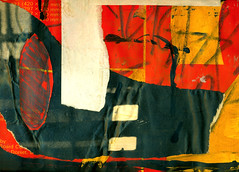
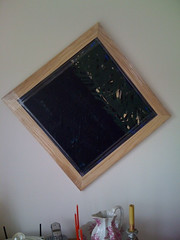 -
-
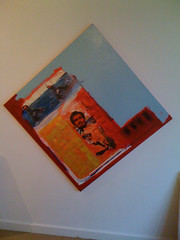
 -
-

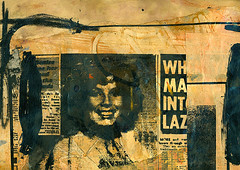
An object or thing never has the same functionality as its name or image.... I think Magritte said something like this 80 or so years ago.
A bit of
an odd statement but if you think about it it is very true. An inert object
(or landscape) can't tell you what it is, we rely on our experiences through
out our lives to explain what we see. If we see a chequered hillside we
know that the boundaries (if they are green) are most likely to be hedges
and the whiteish blobs are probably sheep contained within the fields.
We can estimate the feel of the landscape: warm, cold, steep, flat etc.
In many respects transferring theses visual clues into (in my case) paint
gives a prompt, a reminder of the general feel of the landscape... an
estimate. In all cases the created image lies about its representation.
A representation/illusion takes on more realness than the actual physical
object, the object then becomes a metaphor for the created illusion. This
in turn creates an additional reference for the object, an extra visual
adjective eg. 'The sky was very Turneresque.' Turner's illusion becomes
a metaphor for the real thing, which vividly describes [in words] the
actual sky. The concrete object cannot say everything about itself - it
has a limited vocabulary and is unable to say what is required of it,
it is on many levels mute.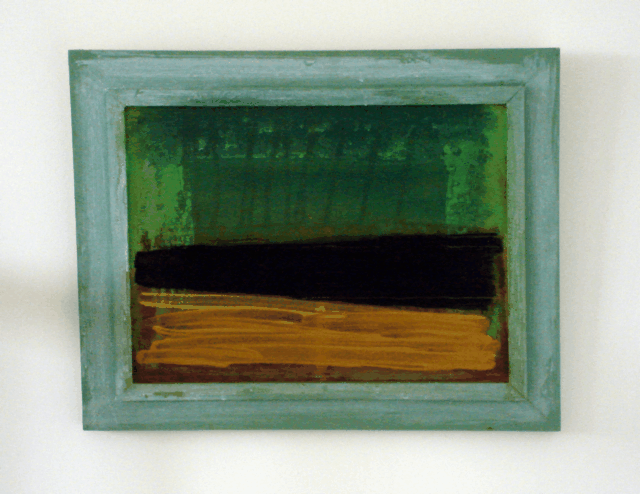 The constant questioning and declassification of what art is and what
the content is has lead to this so called crisis in painting (there as
always been a crisis in painting) - Painting is dead - the exponents of
Conceptual Art tried to destroy the art object but failed - thought and
the idea is the object. The primary aims of Conceptual Art in the 1960's
was to carry out a theoretical examination of 'art' and through understanding
propose 'concepts as art'. Two and three-dimensional art was in the doldrums,
the essence of creating was the new Holy Grail. This was considered to
be a bold step, proposing an idea as a work of art left the Artist with
very little to exhibit or sell, the written word was usually all that
was physically evident....it has taken me nearly 35 years to realize that
what I do isn't pointless and that my unwavering trust in the conceptual
philosophies (of artists and writers from Duchamp to Art and Language)
has been misplaced. I'm enjoying my painting - for the first time. The
'world of art' and the 'world of everyday life' had already been discussed
in Dada. "Life and art are one," proclaimed Tzara. Ultimately Dada reduced
itself to vandalism, drawing moustaches on the Mona Lisa, instead of destroying
the Louvre and genuinly starting again, something a real revolutionary
movement would consider as its first option. It increased the status of
the most banal object or event into something that ultimately provoked
nervous laughter, a childish prank that has been taken seriously ever
since. Conceptual Art attempted to be more serious in its approach. Unfortunately
the original aims became diffused and the quality of thought became diluted
and suffered a similar fate to Dada.
The constant questioning and declassification of what art is and what
the content is has lead to this so called crisis in painting (there as
always been a crisis in painting) - Painting is dead - the exponents of
Conceptual Art tried to destroy the art object but failed - thought and
the idea is the object. The primary aims of Conceptual Art in the 1960's
was to carry out a theoretical examination of 'art' and through understanding
propose 'concepts as art'. Two and three-dimensional art was in the doldrums,
the essence of creating was the new Holy Grail. This was considered to
be a bold step, proposing an idea as a work of art left the Artist with
very little to exhibit or sell, the written word was usually all that
was physically evident....it has taken me nearly 35 years to realize that
what I do isn't pointless and that my unwavering trust in the conceptual
philosophies (of artists and writers from Duchamp to Art and Language)
has been misplaced. I'm enjoying my painting - for the first time. The
'world of art' and the 'world of everyday life' had already been discussed
in Dada. "Life and art are one," proclaimed Tzara. Ultimately Dada reduced
itself to vandalism, drawing moustaches on the Mona Lisa, instead of destroying
the Louvre and genuinly starting again, something a real revolutionary
movement would consider as its first option. It increased the status of
the most banal object or event into something that ultimately provoked
nervous laughter, a childish prank that has been taken seriously ever
since. Conceptual Art attempted to be more serious in its approach. Unfortunately
the original aims became diffused and the quality of thought became diluted
and suffered a similar fate to Dada.
It is possible to tell more about a landscape or object in a painting than to actually experience the real thing - the editing and generalization required in painting enables the experience of the landscape to be viewed in shorthand. The greatest trick is to imply this with the minimum of effort. Unfortunately the majority of landscape art fails miserably however, 'Lake Lucerne: the Bay of Uri from above Brunnen' circa 1844 (below) is the ultimate painting of landscape and nature - it tells a massive story with very little content. This has been an important painting for me since the early 1970's. I have always admired the New York Abstract Expressionists of the mid 20th century but when I first saw this painting by Turner...... my socks were blown off. It is without doubt a clever (maybe unfinished) conceptual painting.

(From the display caption September 2004 Tate Gallery, London)
Road trips, journeys, and speed inspire. The image below was taken on a road trip I did in 2007, with stays in Brussels, Zurich (it was going to be Prague but the German authorities banned us from their country on the outward journey) Zagreb, Munich, Ipers. Going through France, Belgium, Luxemburg, Switzerland, Austria, Slovenia, Croatia and Germany. We did this in six days. Click on the image for more photographs of our 'Cannonball' journey.

